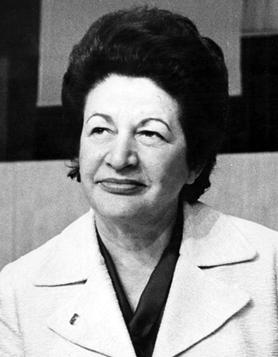Milka Planinc facts for kids
Quick facts for kids
Milka Planinc
|
|
|---|---|

Milka Planinc
|
|
| 25th President of the Federal Executive Council | |
| In office 16 May 1982 – 15 May 1986 |
|
| President | Petar Stambolić Mika Špiljak Veselin Đuranović Radovan Vlajković |
| Preceded by | Veselin Đuranović |
| Succeeded by | Branko Mikulić |
| 7th Secretary of the League of Communists of Croatia | |
| In office 14 December 1971 – 16 May 1982 |
|
| Preceded by | Savka Dabčević-Kučar |
| Succeeded by | Jure Bilić |
| Personal details | |
| Born |
Milka Malada
21 November 1924 Drniš, Kingdom of Serbs, Croats and Slovenes (now Croatia) |
| Died | 7 October 2010 (aged 85) Zagreb, Croatia |
| Political party | League of Communists |
| Spouse |
Zvonko Planinc
(m. 1950; |
| Children | 2 |
Milka Planinc (born Milka Malada; 21 November 1924 – 7 October 2010) was an important Croatian politician. She was active in Yugoslavia during her career. From 1982 to 1986, she served as the Prime Minister of Yugoslavia. She was the first and only woman to hold this high position. Milka Planinc was also the first female head of government in a Communist state in Europe that was recognized by other countries.
Early Life and War Time
Milka Malada was born in 1924 in Žitnić. This small village is near Drniš in Dalmatia, which is now part of Croatia. Her family included both ethnic Croat and ethnic Serb members.
Her schooling was stopped when World War II began. In 1941, she joined the Communist Youth League. This was a very important year for her and for her country. Nazi Germany invaded Yugoslavia, splitting it among different occupying forces.
Soon, a resistance group called the Partisans was formed. They were led by Marshal Josip Broz Tito. Milka Planinc was eager to join the anti-Fascist movement.
At 19, Planinc joined the Partisans. She became very dedicated to Tito. In 1944, she joined the Communist Party of Yugoslavia. She worked as a county commissar for the 11th Dalmatian Shock Brigade. Her job was to teach party ideas and make sure people were loyal to the party.
After the war, the Partisans and the Communist Party took control of the region. Milka Planinc continued her education at the Higher School of Administration in Zagreb. In 1950, she married Zvonko Planinc, an engineer. They had a son and a daughter together.
Rising in Politics
Milka Planinc started a full-time career within the League of Communists of Croatia. She focused on education and spreading party messages. In 1959, she was chosen to be part of the Croatian Central Committee. This was an important executive group.
She held several jobs in Zagreb. In 1957, she was the Secretary of the People's Assembly of Trešnjevka. Then, in 1961, she became the Secretary of Cultural Affairs for the City of Zagreb. By 1963, she was the Secretary of the City of Zagreb League of Communists Committee. She also became the Secretary for Education of the Socialist Republic of Croatia, a role she kept until 1965.
She gained more recognition in the party in 1966. She was elected to the Presidium of the League of Communists of Croatia (LCC). Then, in 1968, she joined the executive committee of the LCC. From 1967 to 1971, she served as the President of the Assembly of the Socialist Republic of Croatia.
After a period of political change known as the Croatian Spring, the leaders of the LCC were replaced. Milka Planinc became the president of the Central Committee in 1971. She played a key role in managing the political situation during this time. She remained the Leader of the League of Communists of Croatia until 1982.
Leading Yugoslavia
When Tito passed away in 1980, he left a plan for Yugoslavia's leadership. It involved a rotation of eight leaders, with each federal unit taking turns. On April 29, 1982, Milka Planinc's list of ministers was approved. On May 15, 1982, she was named head of the Federal Executive Council. This made her the Prime Minister of Yugoslavia.
She was the first woman to hold such a high position in the country's history. Planinc formed a new government body, the Federal Executive Committee. It had 29 members, most of whom were new to their roles.

She served as the President of the Federal Executive Council (Prime Minister) from 1982 to 1986. Her time as prime minister is remembered for the government's decision to manage Yugoslavia's international debt. To do this, her government put in place strict economic rules for a few years.
The 1974 constitution had given the central government less power. Instead, power was divided among the separate republics. Planinc tried to bring more focus back to the central government. She also worked to build international friendships. She visited countries like Britain, the United States, and Moscow. Her visits to Washington brought promises of economic help. Her visit to Moscow was described as not gaining or losing anything significant.
Planinc offered to resign in October 1985, but her resignation was not accepted. In February 1986, her government asked the International Monetary Fund for special monitoring. This request was approved a month later. Her term as Prime Minister ended in May 1986. Soon after, she became a member of the LCY Central Committee.
Later Life
Milka Planinc lived through the Yugoslav Wars and the collapse of communism in Europe. In 1993, her husband passed away. The next year, in 1994, her son Zoran also died.
From the late 1990s until her death, Planinc used a wheelchair and rarely left her home. She lived in Zagreb until she passed away on October 7, 2010, at the age of 85. She was buried at Zagreb's Mirogoj Cemetery.

